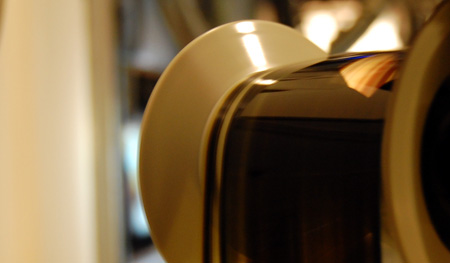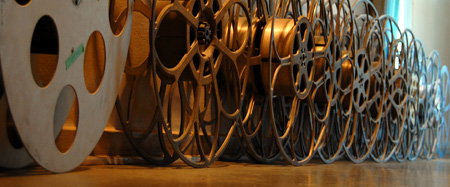Staffing & Training |
Read more
at in70mm.com The 70mm Newsletter |
| Written by: Ramon Lamarca Marques, Brian Guckian and Mike Taylor | Date: 07.03.2009 |
 Image
by Thomas Hauerslev Image
by Thomas Hauerslev70mm presentation raises specific staffing and training issues that need to be fully and effectively addressed before taking on the format. A common error is to assume that 70mm is simply a larger version of 35mm film. In fact the heavier nature and faster linear speed of 70mm, plus the magnetic soundtracks encountered on many archive prints, call for a new approach when handling and projecting the format. Screenings 70mm films in multiplexes (which would be limited to new 65/70mm films only) should have constant projector attendance by a Projectionist specifically rostered for such duty. The greater expense and different dynamics of 70mm prints mean that projector non-attendance of screenings, as common in automated 35mm mulitplexes, cannot be accepted. Additionally, print assembly and disassembly by a Projectionist should be overseen by a supervisor, or knowledgeable second Projectionist. Prints should be assembled and disassembled directly on the platter where the film is to be shown, and there must be no attempted print movements. The purpose of the second Projectionist is to verify that edges of prints are not being improperly dragged across surfaces, that all rollers are correctly threaded, that splices are correctly made [in frame], and to assist in gently stopping the heavy platter, when it's mass and inertia are at the upper levels of loading capacity. Prints must also be thoroughly bench-inspected prior to assembly and standard precautions must be taken where magnetic soundtracks are replayed in specialised screening venues. In Changeover houses, two Projectionists should be on duty to check each other's threading during lace-up of the reels. Thorough training by a specialist expert is essential for 70mm presentation, even for experienced 35mm Projectionists. Training - and evidence of same - should be made a condition for receiving prints. Existing in-house training programmes can be expanded with the help of a knowledgeable engineer, or by sourcing appropriate expertise. The Workshop is grateful to Paul Rayton for his assistance with this article. |
More
in 70mm reading: 65/70mm Workshop Questions on 70mm Projection! The Advanced Projection Manual Internet link: |
Staffing & Training (by Mike Taylor) |
|
 Image
by Thomas Hauerslev Image
by Thomas Hauerslev70mm presentation presents a number of issues to projectionists who have never experienced this large format. I agree with other writers that to assume that 70mm is just a larger version of 35mm is a great mistake. With a number of archive prints in circulation with magnetic soundtracks, a new approach to handling techniques and the manning of projection rooms is called for. The handling of the larger spools and extra weight of the film calls for more attention. Indeed, projection staff must be in attendance at ALL times the screening is under-way. Leaving the projector unattended is not acceptable. Although we do have platter systems that can handle 70mm it is recommended that where archive prints are screened then the ideal situation is for dual machines with change-overs. Print make-up, from renters shipping reels to theatre equipment, is most important. All film must be carefully checked for any signs of damage and extra precautions taken where magnetic soundtracks are part of the film. Theatres booked for 70mm presentation should make sure there are two projectionists on duty for the run of the film. However experienced a projectionist may be - if it is their first experience of 70mm then that second eye to check all lacing up, switching etc. etc. should ensure a perfect presentation. The double-checking of platter projection ensures all rollers are free and feeding the film correctly. Rewind room procedure calls for extreme cleanliness at all times whilst handling film. The second eye may spot something the other projectionist may have missed either during make-up or projection. If any theatre is not sure if their projectionists are happy with 70mm then it is a good idea to call on a specialist expert to help with in-house training - this not only helps the staff but also ensures the theatre has a good relationship with film renters. |
|
|
Go: back
- top - back issues
- news index Updated 21-01-24 |
|
